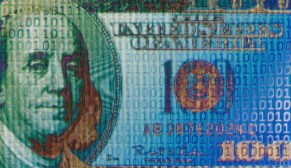 Government. Mural by Elihu Vedder (Source: Library of Congress)
Government. Mural by Elihu Vedder (Source: Library of Congress)Imagine you’re reviewing historical photos or documents and could use your smartphone to take a photo, add meta tags and share this on a centralized website where others could view, contribute and collaborate with you on its details.
National Archives Chief Innovation Officer Pamela Wright wants an app for that.
The app, what she calls the “Pocket Archivist,” is an example of the type of collaboration that gets America closer to “government of the people, by the people, for the people,” says Wright.
“We would like to create an app for engagement,” she said. “We want to create a simple tool for citizens that will allow them to contribute to our mission of providing better access to our records. And the records we are talking about are the permanent records of the federal government. We hold American history in our hand. We want to share it, and we know there are citizens who want to help.”
When it comes to exploring the past, crowdsourcing and social media is the future of history, Wright says, and integral to making “democracy better for the average citizen. What’s really changed in the last five years or so is the opportunity for the National Archives to use social media. The concept is no longer ‘we have to bring people in to us,’ it’s ‘we have to go out where people spend their time online,” she said.
She has the numbers to back this up.
According to Wright, 2011 was a “watershed year” for public access and the National Archives. Three million people visited its 44 facilities throughout the United States. Its website, archives.gov, had 18 million visitors. But, for the first time in its history, the impact of social media visitors eclipsed the website with approximately 22 million reaches.
And the views of the National Archives records on Wikipedia, she said, “blows all of those numbers out of the water.”
“It’s amazing how much access you get with a Wikipedia article if it’s topically hot and people start to look on Wikipedia for information and it draws from one of the digital images of one of our documents,” she said.
Wright was appointed NARA’s first chief innovation officer in December. She’s charged with creating an innovation office to help infuse innovative practices throughout the agency, but also to look at emerging culture and how federal archival materials can better interact with an increasingly digital citizenry.
Despite the new assignment, Wright is no stranger to embracing the technology revolution. She previously served as the agency’s first chief digital access strategist, where she led the launch of many of NARA’s social media initiatives, as well as the open collaboration platform the Citizen Archivist Dashboard, which allows citizens to help transcribe historical documents.
To facilitate a culture of innovation throughout the agency, NARA is planning to host internal detailees, where select employees will spend time working on innovative projects that will be nurtured and encouraged by senior leaders. Unlike other innovation labs that operate in separate skunkworks environments, the idea of rotating employees through an internal program is much more appealing to Wright.
The “innovation hub,” as she calls it, will give detailees the “feeling of skunkworks in that they’re not doing their regular duties, but will be able to focus on a particular project for a specific period of time, and there’s a deliverable at the end of it. The detailees can then take their projects back to ignite innovation in their offices as well. That way, we’re integrated in with the rest of the agency. ”
“We want to make sure the entire agency gets a lift from the work that we’re doing,” she said.
Based on activity she sees on the agency’s internal collaboration network, which connects NARA’s 3,500 employees from all across the country, Wright is optimistic.
“I’m seeing all kinds of innovative ideas posted, so I know there are people across the agency who are willing and eager to do some of these projects.”
The opportunity for NARA to think outside the box couldn’t come at a better time. Its mission, to preserve the permanent records of the federal government and to provide full access to those records, becomes more challenging with the increased volume of information, including text, audio and video.
“We have over 10 billion pages of textual records alone. But that’s just the start. We also have millions of maps, charts, architectural drawings, hundreds of thousands of sound and video recordings, over 35 million photos and posters, and hundreds of terabytes of electronic records.”
“Making our records digitally accessible is one of the biggest issues of our time,” said Wright.
For an agency charged with preserving America’s past, its prologue now comes with a federal declaration of innovation.






